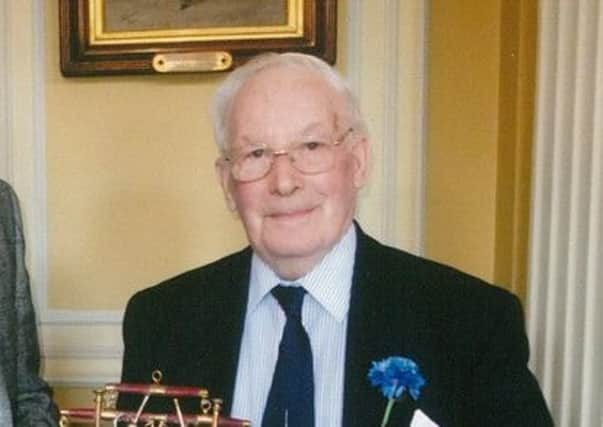John Roger


John Roger, who died last week, spent a lifetime working with horses and capped his reputation as an expert carriage driver by driving a coach and horses across London Bridge.
His interest in horses started back in 1936 when, as a nine-year-old pupil at Kemback Primary school, he took his pony and trap to and from school, leaving the local minister to provide stabling during school hours. Although later on he travelled the world, he never lost his love for the local area, requesting his last resting place should be the graveyard at Kemback.
Advertisement
Hide AdAdvertisement
Hide AdHis father farmed Rumgally and John followed in his footsteps, learning the business from a young age. As a schoolboy, he could recall his father buying Irish cattle in Cupar market, leaving John and a few other laddies to bring them home. Many years later, with his trademark dry humour, he recalled these journeys along the relatively traffic-free roads. “They (the cattle) were long legged and we were short legged and they were a bit quick.”
Night classes at Bell Baxter school increased his farming knowledge. He was also one of the early members of Bell Baxter Agricultural Discussion Society which was formed prior to the setting up of the Scottish Association of Young Farmers Clubs.
Later on in life, he was president of Fife show and served for a number of years as a regional director of the Royal Highland Society.
With Rumgally farm lying adjacent to the only sugar beet factory in Scotland, that crop featured in the rotation up until the factory closed in 1970.
While still at school during the war years, he and his brothers used to take their ponies to the Fife Foxhound Hunt kennels to help the huntsmen on a Saturday. There, they would take the hounds out for any members of the Hunt who were home on leave from the war.
Indirectly, the war also provided him with his first hunter as the owner did not want to see the horse go off to the battlefields; this being still a possibility in the early days of the Second World War.
Gradually his involvement with Fife Foxhounds grew and he was appointed joint master. With his own background in farming, he used to visit all the farms where the hunt was planned to go in order to find out if there were any problems. In the immediate post war-years, tenant farmers would often have a clause in their lease so that they had to allow hunting over their land as most of the lairds were keen on it. With hunts taking place twice a week in the season, John could claim with justification that he knew every field and gate in north-east Fife.
Two changes to farming practices curtailed hunting in the post-war years. The first was an increase in growing winter cereals where damage would be caused if the hunt trampled over the recently-sown crop.
Advertisement
Hide AdAdvertisement
Hide AdThe second and less obvious restriction came in the battle to eradicate bovine tuberculosis. Farmers were required to have double fences to prevent the spread of the disease and protect their cattle. As he used to remark, “Not many hunt followers were willing to risk their lives taking their horses over double fences.”
He claimed his enjoyment in fox hunting came from watching the hounds working, saying you could tell the good hounds. These were the ones that would find a line and “speak” to the others to follow. Others, he said, were not so clever.
After an introduction to carriage driving, that sport became his main interest. His schoolboy knowledge of driving a pony and trap using long reins was soon expanded with a pair of hackneys that provided him with a fair amount of success initially in the UK and latterly on the Continent.
After one successful foray in Belgium where the prize included two crates of Champagne, he was faced with a dilemma of getting his prize back through customs. Many years later, he recalled that to ensure there were no breakages, the bottles were stored safely in the horses’ hay and the customs officers showed no desire to search the animal food store.
Confirmation of his skills with horses came in 1980 as he won the national championship at Sandringham and, proving this was no flash in the pan, he also twice won at the Royal Windsor. His competitive instinct saw him challenge in five European Driving Championships.
His reputation and skills with horses then saw him being asked to take clinics in the United States and thereafter in Argentina. When the plan to train carriage drivers in this South American country fell through, he spent time working on a cattle ranch with the local gauchos instead. After working with them, he was full of admiration of their horsemanship, saying: “They just lived on their horses.”
Word of his own top horsemanship went around and he was contacted by businessman Brian Souter of Stagecoach fame, who asked if he would like to drive a traditional stagecoach at various events linked to new Stagecoach business ventures.
This was a new challenge which involved getting four horses to work as a team. As he worked on this, he would often be seen around the country roads in north-east Fife with his team of four perfecting his techniques and getting them to pull together.
Advertisement
Hide AdAdvertisement
Hide AdThis extension of his life with horses saw him drive his team of four onto the concourse at Waverly Station in Edinburgh and on another occasion in London where, in a scene reminiscent of a previous century, he drove the coach and horses across London Bridge.
He is survived by his wife Doris, son Aubin, daughter Doreen, four grandchildren and one great grandchild.
ANDREW ARBUCKLE